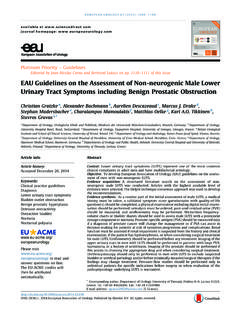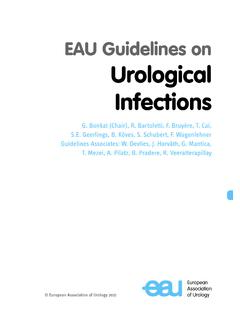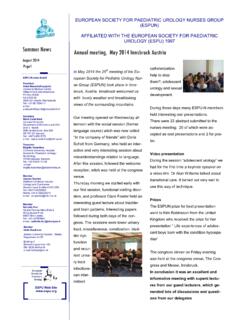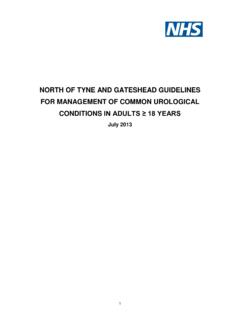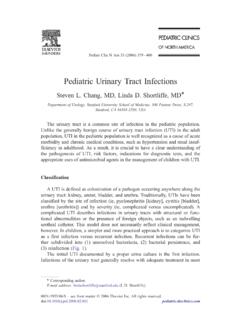Transcription of Guidelines on Paediatric Urology - Uroweb
1 Guidelines onPaediatricUrologyS. Tekg l, H. Riedmiller, Dogan, P. Hoebeke, R. Kocvara, R. Nijman, Chr. Radmayr, R. Stein European Society for Paediatric Urology European Association of Urology 20132 Paediatric Urology - UPDATE MARCH 2013 TABLE OF CONTENTS PAgE1. METHODOLOGY 7 Introduction 7 Data identification and evidence sources 7 Level of evidence and grade of recommendation 7 Publication history 8 Summary of updated and new information 8 Potential conflict of interest statement 8 References 92. PHIMOSIS 9 Background 9 Diagnosis 9 Treatment 9 Conclusions and recommendations on phimosis 10 References 103. CRYPTORCHIDISM 11 Background 11 Diagnosis 11 Treatment 12 Medical therapy 12 Surgery 12 Prognosis 12 Recommendations for cryptorchidism 13 References 134. HYDROCELE 14 Background 14 Diagnosis 15 Treatment 15 Recommendations for the management of hydrocele 15 References 155.
2 ACUTE SCROTUM IN CHILDREN 16 Background 16 Diagnosis 16 Treatment 17 Epididymitis 17 Testicular torsion 17 Surgical treatment 17 Prognosis 17 Fertility 17 Subfertility 18 Androgen levels 18 Testicular cancer 18 Nitric oxide 18 Perinatal torsion 18 Recommendations acute scrotum in children 18 References 196. Hypospadias 22 Background 22 Risk factors 22 Diagnosis 22 Treatment 22 Age at surgery 23 Penile curvature 23 Preservation of the well-vascularized urethral plate 23 Re-do hypospadias repairs 24 Urethral reconstruction 24 Paediatric Urology - UPDATE MARCH 2013 3 Urine drainage and wound dressing 24 Outcome 24 Conclusions and recommendations 25 References 257. CONGENITAL PENILE CURVATURE 28 Background 28 Diagnosis 28 Treatment 28 References 288. VARICOCELE IN CHILDREN AND ADOLESCENTS 28 Background 28 Diagnosis 29 Therapy 29 Conclusions and recommendations 30 References 309.
3 URINARY TRACT INFECTIONS IN CHILDREN 31 Introduction 31 Classification 32 Classification according to site 32 Classification according to episode (10) 32 Classification according to severity 32 Classification according to symptoms 32 Classification according to complicating factors (12) 33 Diagnosis 33 Medical history 33 Clinical signs and symptoms 33 Physical examination 33 Urine sampling, analysis and culture 33 Urine sampling 33 Urinalysis 34 Urine culture 35 Therapy 35 Administration route 35 Duration of therapy 35 Antimicrobial agents 36 Chemoprophylaxis 38 Monitoring of UTI 38 Imaging 38 Ultrasound 38 Radionuclide scanning 38 Voiding cystourethrography 39 Bladder and bowel dysfunction 39 Conclusions and recommendations for UTI in children 39 References 4010. DAYTIME LOWER URINARY TRACT CONDITIONS 44 Background 44 Definition 44 Filling-phase dysfunctions 45 Voiding-phase (emptying) dysfunctions 45 Diagnosis 45 Treatment 45 Standard therapy 45 Specific interventions 46 References 4611.
4 MONOSYMPTOMATIC ENURESIS 47 Background 47 Definition 484 Paediatric Urology - UPDATE MARCH 2013 Diagnosis 48 Treatment 48 Supportive treatment measures 48 Alarm treatment 48 Medication 49 References 5012. MANAGEMENT OF NEUROGENIC BLADDER IN CHILDREN 50 Background 50 Definition 51 Classification 51 Urodynamic studies 51 Method of urodynamic study 52 Uroflowmetry 52 Cystometry 52 Management 53 Investigations 53 Early management with intermittent catheterisation 53 Medical therapy 53 Botulinum toxin injections 53 Management of bowel incontinence 54 Urinary tract infection 54 Sexuality 54 Bladder augmentation 54 Bladder outlet procedures 54 Continent stoma 55 Total bladder replacement 55 Lifelong follow-up of neurogenic bladder patients 55 References 5513. DILATATION OF THE UPPER URINARY TRACT (URETEROPELVIC JUNCTION AND URETEROVESICAL JUNCTION OBSTRUCTION) 61 Background 61 Diagnosis 61 Antenatal ultrasound 61 Postnatal ultrasound 61 Voiding cystourethrogram (VCUG) 61 Diuretic renography 61 Treatment 62 Prenatal management 62 UPJ obstruction 62 Megaureter 62 Conservative management 62 Surgical management 63 Conclusion 63 Conclusions and recommendations for UPJ-, UVJ-obstruction 63 References 6314.
5 VESICOURETERIC REFLUX IN CHILDREN 64 Methodology 64 Background 64 Diagnostic work-up 65 Infants presenting because of prenatally diagnosed hydronephrosis 66 Siblings and offspring of reflux patients 66 Children with febrile urinary tract infections 67 Children with lower urinary tract symptoms and vesicoureteric reflux 67 Treatment 67 Conservative therapy 67 Follow-up 68 Continuous antibiotic prophylaxis (CAP) 68 Surgical treatment 68 Subureteric injection of bulking materials 68 Paediatric Urology - UPDATE MARCH 2013 5 Open surgical techniques 69 Laparoscopy 69 Recommendations for the management of vesicoureteric reflux in childhood 69 References 7115. URINARY STONE DISEASE 75 Background 75 Stone formation mechanisms, diagnosis of causative factors and medical treatment for specific stone types 75 Calcium stones 76 Uric acid stones 77 Cystine stones 77 Infection stones (struvite stones) 77 Clinical presentation 78 Diagnosis 78 Imaging 78 Metabolic evaluation 78 Management 80 Extracorporeal shock wave lithotripsy (SWL) 80 Percutaneous nephrolithotomy 80 Ureterorenoscopy 81 Open stone surgery 81 Conclusions and recommendations 82 References 8316.
6 OBSTRUCTIVE PATHOLOGY OF RENAL DUPLICATION: URETEROCELE AND ECTOPIC URETER 87 Background 87 Ureterocele 88 Ectopic ureter 88 Definition and classification 88 Ureterocele 88 Ectopic (extravesical) ureterocele 88 Orthotopic (intravesical) ureterocele 88 Ectopic ureter 88 Diagnosis 89 Ureterocele 89 Ectopic ureter 89 Treatment 89 Ureterocele 89 Early treatment 89 Re-evaluation 89 Ectopic ureter 90 Conclusions and recommendations for obstructive pathology of renal duplication: ureterocele and ectopic ureter 91 References 9117. DISORDERS OF SEX DEVELOPMENT 94 Background 94 Micropenis 94 Background 94 Diagnosis 95 Treatment 95 The neonatal emergency 95 Family history and clinical examination 95 Choice of laboratory investigations 96 Gender assignment 96 Role of the Paediatric urologist 96 Diagnosis 97 Clinical examination 97 Investigations 97 Management 97 Feminising surgery 986 Paediatric Urology - UPDATE MARCH 2013 Masculinising surgery 98 Guidelines for the treatment of disorders of sex development 98 References 9918.
7 POSTERIOR URETHRAL VALVES 100 Background 100 Classification 100 Urethral valve 100 Diagnosis 100 Treatment 101 Antenatal treatment 101 Postnatal treatment 101 Summary 104 Conclusions and recommendations posterior urethral valves 104 References 10419. Paediatric UROLOGICAL TRAUMA 106 Background 106 Paediatric renal trauma 106 Diagnosis 107 Haematuria 107 Blood pressure 107 Choice of imaging method 107 Treatment 108 Guidelines for the diagnosis and treatment of Paediatric renal trauma 108 Paediatric ureteral trauma 108 Diagnosis 108 Treatment 108 Guidelines for the diagnosis and treatment of Paediatric ureteral trauma 109 Paediatric bladder injuries 109 Diagnosis 109 Treatment 109 Intraperitoneal injuries 109 Extraperitoneal injuries 109 Guidelines for the diagnosis and treatment of Paediatric bladder injuries 110 Paediatric urethral injuries 110 Diagnosis 110 Treatment 110 Guidelines for the diagnosis and treatment of Paediatric trauma 111 References 11120.
8 POST-OPERATIVE FLUID MANAGEMENT 112 Background 112 Pre-operative fasting 112 Maintenance therapy and intra-operative fluid therapy 113 Post-operative fluid management 114 Post-operative fasting 114 Summary conclusions and recommendations 115 References 11521. POST-OPERATIVE PAIN MANAGEMENT IN CHILDREN: GENERAL INFORMATION 116 Introduction 116 Assessment of pain 117 Drugs and route of administration 117 Circumcision 117 Penile, inguinal and scrotal surgery 117 Bladder and kidney surgery 120 Conclusions and recommendations 120 References 12022. ABBREVIATIONS USED IN THE TEXT 126 Paediatric Urology - UPDATE MARCH 2013 71. IntroductionA collaborative working group consisting of members representing the European Society for Paediatric Urology (ESPU) and the European Association of Urology (EAU) has prepared these Guidelines to make a document available that may help to increase the quality of care for children with urological problems.
9 This compilation document addresses a number of common clinical pathologies in Paediatric urological practice, but covering the entire field of Paediatric Urology in a single guideline document is unattainable, nor practical. The majority of urological clinical problems in children are distinct and in many ways different to thosein adults. This publication intends to outline a practical and preliminary approach to Paediatric urological problems. Complex and rare conditions that require special care with experienced doctors should be referred to designated centres where Paediatric Urology practice has been fully established and a multidisciplinary approach is available. For quite some time, Paediatric Urology has informally developed, expanded, matured and established its diverse body of knowledge and expertise and may now be ready to distinguish itself from its parent , Paediatric Urology has recently emerged in many European countries as a distinct subspecialty of bothurology and Paediatric surgery, and presents a unique challenge in the sense that it covers a large area withmany different schools of thought and a huge diversity in management.
10 Knowledge gained by increasing experience, new technological advances and non-invasive diagnosticscreening modalities has had a profound influence on treatment modalities in Paediatric Urology , a trend that islikely to continue in the years to come. We now have new techniques for the treatment of reflux, our techniquesfor the treatment of complex congenital anomalies have substantially improved, and totally new technologies for bladder replacement and laparoscopic procedures have been developed. Data identification and evidence sourcesThe Guidelines were compiled based on current literature following a systematic review using MEDLINE. Application of a structured analysis of the literature was not possible in many conditions due to a lack of well-designed studies. Due to the limited availability of large randomised controlled trials (RCTs) - influenced also by the fact that a considerable number of treatment options relate to surgical interventions on a large spectrum of different congenital problems - this document will largely be a consensus document.

